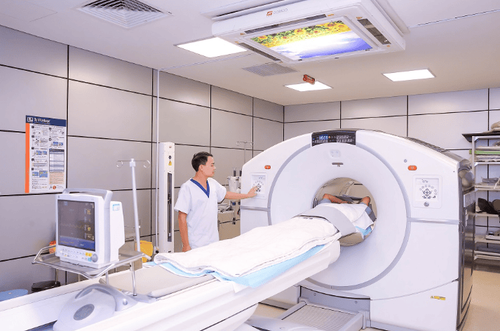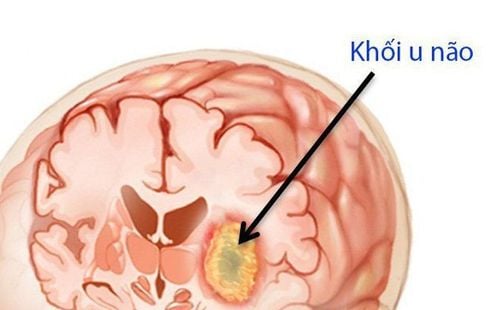This is an automatically translated article.
Metastatic brain tumors are brain tumors that originate in tissues or organs outside of the brain. Brain metastasis is a common complication of systemic cancer, causing morbidity and mortality in cancer patients. Metastatic brain tumors are the most common intracranial tumors, or intracranial tumors, with a possibly increasing incidence.1. What is metastatic brain tumor?
Metastatic brain tumor is the spread of an original tumor to the brain, which is different from the primary brain tumor. The difference between these two types of brain damage is confusing for many people. For example, a patient with lung cancer has a tumor that first forms in the lung tissue, and then cells from the tumor that separate from the original tumor travel through the bloodstream or lymphatic system to other organs. body, including the brain. Tumor that has spread far is called “metastasis”. When lung cancer metastasizes to the brain, the “brain tumor” is actually lung cancer cells.2. Common symptoms of brain metastasis
One or more brain tumors will cause one of the following symptoms:
Increased intracranial pressure: In most patients, the symptoms of brain metastases appear as a result of the growth and development of the brain. damage to the brain and cause increased pressure inside the skull (increased intracranial pressure). The most common symptoms of increased intracranial pressure are vomiting, headache, and confusion. Headache: About half of patients with metastatic brain tumors present with headache. Headache is a symptom experienced by most patients at some point during the progression of a metastatic brain tumor. Vomiting: Vomiting is often accompanied by a headache. Vomiting is more common in children than in adults. Vomiting in children can be very dramatic and intense.

Nôn mửa, đau đầu là triệu chứng ung thư di căn não thường gặp
Loss of consciousness and reduced alertness: Patients with metastatic brain tumors often experience reduced alertness or loss of consciousness at some point. Brain tumors can affect mental state in varying degrees, from mild personality changes to deep and irreversible comas. Seizure seizures: Epilepsy is commonly associated with brain tumors in approximately 35% of patients with metastatic brain tumors. Age can increase the risk of tumour-related seizures, especially in people over 45 years of age. Focal neurological symptoms: While headaches, altered mental status, and seizures can occur with tumors at various locations in the brain, several other symptoms are related to location. specific location of metastatic brain tumors. These focal neurological symptoms usually affect the part of the body on the side opposite the side where the tumor exists. For example, a tumor on the right side of the brain can cause sensory disturbances that may include numbness, loss of sensation or movement such as weakness in the muscles on the left side of the body.
3. Causes of brain metastases
Metastatic brain tumors occur when cancer cells travel in the bloodstream or lymphatic system from the original tumor, spreading (metastasize) to the brain. In the brain, metastatic cells begin to multiply. Metastatic cancer that has spread from the original site is called primary cancer. For example, cancer that has spread from the breast to the brain is called metastatic breast cancer, not brain cancer.

Các tế bào ung thư di chuyển trong máu, từ khối u ban đầu đến não gây ra u não do di căn
4. Risk factors for metastatic brain tumors
The exact incidence of metastatic brain tumors is unclear. Studies show that the rate of cancer patients with metastatic brain tumors is about 10 - 30%.
Any malignancy can metastasize to the brain causing metastatic brain tumours , however, the incidence of brain metastases varies depending on the type of cancer. Lung cancer, breast cancer, kidney cancer, colon cancer, and melanoma are the most common brain metastases. Primary lung cancer is the most common, accounting for 30-60% of all brain metastases. About 20-30% of breast cancer patients will develop brain metastases.
The likelihood of having a metastatic brain tumor also varies with age. People between the ages of 40 and 60 have the highest risk and tend to decrease after that. The rate of metastatic brain tumors in children is lower than in adults, with frequencies ranging from 6 to 13%.
Although metastatic brain tumors occur with similar frequency in men and women, some sex differences are noted depending on the type of primary cancer. Lung cancer is the most common source of metastatic brain tumors in men, while in women the most common source is breast cancer.
5. How is metastatic brain tumor diagnosed?
When a metastatic brain tumor is suspected, your doctor may recommend a number of tests and procedures including:
Neurological exam : A neurological exam may include testing for vision, hearing, and ability your balance, coordination, strength and reflexes. Partial difficulty can provide clues as to which part of the brain is damaged by the tumor.
Diagnostic Imaging: Magnetic resonance imaging (MRI) is commonly used to help diagnose brain metastases. A dye may be injected into a vein in your arm during the MRI scan. Several types of specialized MRI scans, including functional MRI, cerebral perfusion MRI, and magnetic resonance spectroscopy, help doctors evaluate tumors and plan treatment.
Other imaging tests may include computed tomography (CT) and positron emission tomography (PET). For example, if the primary tumor causes unknown brain metastases, the patient may have a CT scan of the chest to look for lung cancer.

Hệ thống máy chụp PET/CT tại Bệnh viện Đa khoa Quốc tế Vinmec giúp chẩn đoán chính xác các loại u gây ung thư
Collecting and testing a sample of abnormal tissue (biopsy): A biopsy may be taken during surgery to remove a brain tumor or may be done with a needle aspiration. The biopsy sample is viewed under a microscope to determine whether it is cancerous (malignant) or noncancerous (benign), and whether the cancer cells have spread from a primary tumor. This information is crucial for diagnosis, prognosis, and treatment guidance.
6. Treatment of brain tumors caused by metastases
Metastatic brain tumors often respond to treatment if diagnosed and treated early. These treatments can ease symptoms, slow tumor growth, and prolong life.
Treatment options for people with metastatic brain tumors usually include medications, surgery, focused radiation surgery, whole brain radiation, or a combination of these. Chemotherapy and immunotherapy work in some cases. Tumors may recur after treatment.
The best treatment for you will depend on the size, number and location of the tumor, as well as your overall health and desires. Talk to your doctor about your treatment goals to find the treatment that works best for you.
The following are possible treatments for patients with metastatic brain cancer:
6.1 Medicines Use high doses of corticosteroids to reduce swelling around the tumor and reduce neurological signs and symptoms terrible.
6.2 Surgery If the metastatic brain tumor is in an accessible location during surgery, surgery will be an option. The surgeon will cut to remove as much of the cancer as possible. Even removing part of a tumor can reduce a patient's signs and symptoms.
Surgical removal of brain metastases has many risks such as nerve paralysis, infection, and bleeding. Other risks may depend on the part of the brain where the tumor is located. For example, surgery for a tumor located near a nerve that connects to the patient's eye can carry the risk of vision loss.
6.3 Radiation Therapy Radiation therapy is the use of high-energy beams like X-rays, to kill cancer cells. For metastatic brain tumors, treatment may include one or both of the following radiation therapies:
Whole brain radiation therapy : Whole brain radiation therapy applies radiation to the entire brain to kill cancer cells. letters. This process usually requires 10 - 15 treatments over 2 - 3 weeks. Side effects may include fatigue, nausea, and hair loss. In the long term, whole brain radiation is associated with cognitive decline.
Focused radiation surgery (SRS): This method uses a beam of radiation that is not too strong, but the radiation receiving point at the brain tumor will receive a very large radiation dose to kill cancer cells.
SRS is usually done in one treatment, and doctors can destroy multiple tumors in one treatment. Most cases can go home the same day. Side effects may include nausea, headache, convulsions, dizziness or lightheadedness. After SRS treatment, the risk of long-term cognitive decline is thought to be less than with whole brain radiation.
In recent years, as medicine has progressed, doctors and researchers have made significant strides in their understanding of whole brain radiotherapy, focused radiosurgery, and the extent to which it affects the brain. of these two methods on the patient's survival chances, cognitive ability and quality of life. To decide which type of radiation therapy to use, the patient and doctor will consider many factors, including other treatments the patient is having and the likelihood of the cancer coming back after treatment.

Điều trị ung thư di căn não bằng phương pháp xạ phẫu não SRS tại Bệnh viện Đa khoa Quốc tế Vinmec
6.4 Rehabilitation After Treatment Since brain tumors can affect a patient's skills including movement, speech, vision and thinking, rehabilitation may be an inevitable part of the general recovery. Rehabilitation measures after treatment include:
Physical therapy helps patients regain motor skills or muscle strength. Occupational therapy helps patients regain skills needed for normal daily living, including work. Speech therapy with specialists who specialize in the treatment of speech and speech difficulties (speech pathologists). 6.5 Supportive (palliative) care Palliative care is special medical care that focuses on relieving pain and alleviating symptoms of a serious illness. Palliative care professionals work with patients, families, and physicians to add additional treatment support.
Palliative care is provided by a team of medical, psychological, spiritual and social care professionals. This group of care activities will help improve the quality of life for cancer patients and their families.
7. Prevention of brain metastasis
To reduce the complications of metastatic brain tumor requires proper diet and exercise:Regular gentle exercise: If your doctor agrees, start doing light exercise a few times a week. and increase if you feel good. Patients may consider walking, yoga, or practicing tai chi. Reduce stress: Take control of the stress in your own daily life. You can try stress-reduction techniques like: muscle relaxation, visualization, and meditation. In summary, metastatic brain tumor is a dangerous disease and has an increasing incidence rate. Therefore, when seeing abnormal signs, patients should immediately go to a medical facility for examination and appropriate treatment.
SEE ALSO:
Manifestations of metastatic brain cancer How does metastatic cancer occur? What types of cancer are most curable?













